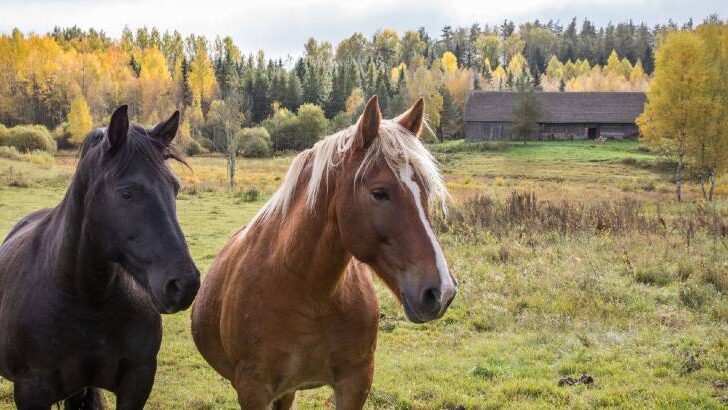Affiliate Disclaimer
As an Amazon Associate I earn from qualifying purchases. It helps me keep the website going. Thank you for your support.
Having your own horse can be one of life’s greatest pleasures. There is nothing better than enjoying a sunrise with the sound of your best friend munching on hay or grass. Most horse lovers dream of having horses right outside their kitchen window. But how much land does a horse need? Do you have enough space for a horse?
As a general rule, a single horse will need between one to five acres of land. The amount of land required depends on the pasture and soil quality, type, and size of horse and management practices. It will also need to be compliant with the stocking rates and zoning rules for your state.
Setting up your land for horses can be a lengthy but worthwhile process. Considering how much land a horse needs is the first step. Read on to learn more about how much land you need to keep and exercise different types of horses.
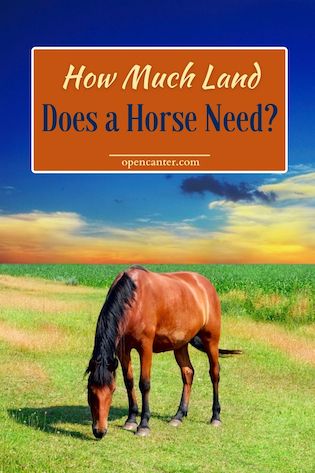
How Much Land Does a Horse Need to Graze?
Horses are designed to be trickle feeders and to eat little and often. They graze throughout the day to meet this need. The amount of land required to feed a horse solely through grazing depends on the pasture quality.
Areas with good soil quality and high levels of rainfall can produce good-quality pasture that can easily sustain horses. More land is required to meet the horse’s needs when there is less pasture, or it is poor quality.
Many owners feed their horses hay, to supplement their diet when pasture is not enough. This can mean horses can be kept on smaller areas of land. However, horses should not be kept on land smaller than one to two acres. This is because the horse won’t have enough room to move around and will destroy the soil and grass.
How Much Land Do You Need to Exercise a Horse?
The area of land you will need to exercise your horse depends on the work you plan on doing. If you do a lot of groundwork, a smaller area is better. It is also helpful if this small area is fenced.
If you are riding your horse, an area of 20 meters by 20 meters at a minimum is recommended. This allows you to ride the horse on a decently sized circle. However, ideally, the area will be larger, such as 40 or 60 meters long by 20 or 30 meters wide. This allows you to vary your riding activities to keep the horse interested (source).
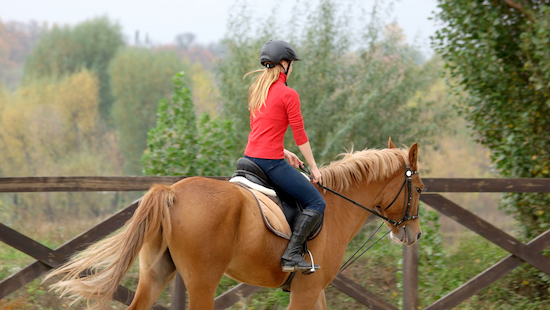
Can I Exercise My Horse in The Field, Or Do I Need a Separate Area?
You don’t need a separate piece of land to exercise your horse. You can exercise your horse in their field, provided the land is suitable. When choosing an area to ride, the land should be relatively flat and free of rocks, holes, or mounds.
However, if you ride in your horse’s field, the pasture and soil may be affected. Riding when it is wet can be dangerously slippery, as well as turning the field into a muddy mess. Repeatedly riding on the same track can kill grass by breaking up the root system.
If you have riding equipment like poles or jumps, it is not ideal to leave these in the horse’s field. The horse may injure themselves on the equipment while they are loose in the field. They may also damage your equipment, which can be costly to replace.
Professional trainers and serious riders will usually have separate areas to exercise their horses. This is so that multiple horses can be worked at once, and that the space is safe for young horses. It also means equipment can be left set up without the risk of injury or damage.
Often land set aside for exercising horses is fenced to a particular size. For example, dressage riders may fence a 60-meter by 20-meter area to replicate a dressage arena. Additionally, the land may be improved in some way, by adding sand or building an arena.
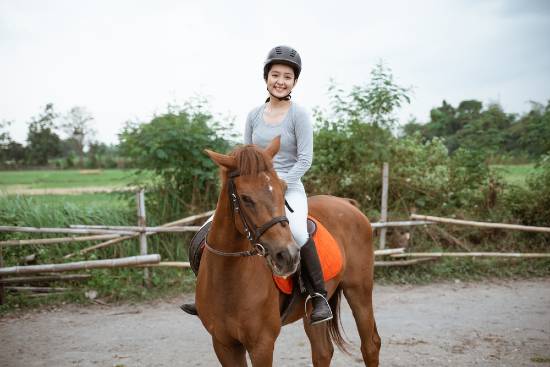
You might also take your horse on trail rides or rides outside of their field on your property. This can provide variety for the horse and give conditioning benefits. Some riders incorporate hill work into their exercise programs. Walking, trotting, and cantering up and down hills helps to build muscle and balance.
Is More Space Always Better For The Horse?
Horses like to have room to move around, run, play, and graze. However, there are some instances where horses are better off having less space.
If a horse is injured, it is sometimes better to restrict that horse’s movement until the injury heals. Confining the horse to a stable or small yard is often part of the veterinary recommended treatment. Injuries that might require confinement include muscle or tendon strains or tears, fractures, or large cuts.
Horses that are hard to catch are often better off being kept in smaller areas. The smaller the area, the harder it is for the horse to play ‘dodgeball’ with a human. However, the horse should be trained to become easier to catch over time.
Horses that are captured from the wild or that have been abused are also better off with less space. This is so humans can interact with them from a short distance and teach them there is nothing to fear. Young horses are often also trained in small areas, to decrease the risk of accidents.
Do You Need More Land If You Have More Than One Horse?
The more horses you have, the more land you will need to keep them. Alternatively, you will need to buy in more feed to keep more horses on the same amount of land.
It is generally recommended that for each extra horse, there needs to be an extra one to three acres of land available. The amount of land required increases if the pasture quality is poor. It is important to ensure that there is enough room for the horses to move around.
Overstocking fields will lead to soil and pasture damage. It might also lead to more frequent injuries to horses that are kept in groups. This is because the less dominant horses don’t have enough room to escape other horses if they are aggressive.
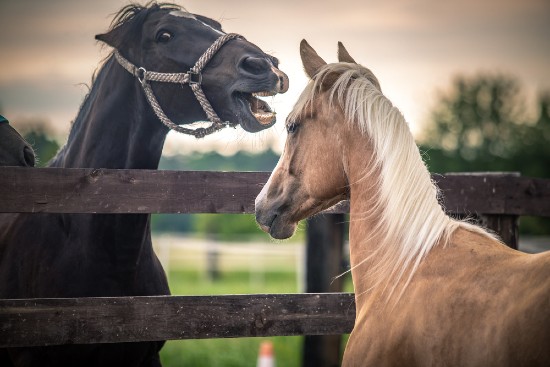
Does The Size or Breed of The Horse Alter How Much Land They Need?
Horses of different sizes and breeds all have different nutritional requirements. Miniature horses can be kept on smaller amounts of land than Shire horses. This is because Miniature horses require less feed and have less impact on the land.
Some breeds of horses are referred to as “easy keepers”. This means that they have a slower metabolism than other breeds and require fewer calories to maintain weight. These horses can be tricky to manage, as they still need to trickle feed throughout the day.
Easy keepers often benefit from smaller amounts of land, especially where pasture is lush. This is so their grazing and carbohydrate intake can be controlled. Their feed will likely need to be supplemented with low-sugar hay to replace the lack of grass.
If not managed properly, these horses can become obese or develop illnesses like laminitis or Equine Metabolic Syndrome. Examples of breeds that are commonly easy keepers include the Welsh pony, Shire, and Quarter Horse.
Horses who are “hard keepers” require a diet richer in energy to maintain their weight. These horses can be found in large grassy fields yet may still require supplementary feeding. Larger areas may be more suitable for these horses. Alternatively, several smaller fenced fields can constantly rotate the horse onto fresh grass.
Are There Any Laws About How Much Land a Horse Needs?
The legal requirements for land or field size for horses vary depending on location. The generally accepted minimum requirement is one to five acres per horse.
Most states have a stocking rate that will tell you how much land a horse needs. For example, Colorado requires a minimum land size of five acres for one horse, whereas Tennessee only requires two acres. Texas generally only requires one acre per horse.
There may be other rules, such as a maximum distance from the owner’s normal address or regulated buildings. Different areas of land may be subject to zoning laws which means you cannot use that land for a horse field. For example, residential zones typically prohibit the keeping of horses and livestock, unless you apply for an exemption. These rules are in place due to the typical lot size, and to preserve the quality of living for neighbors.
Land in farming zones is typically larger and has fewer restrictions when it comes to keeping horses (source).
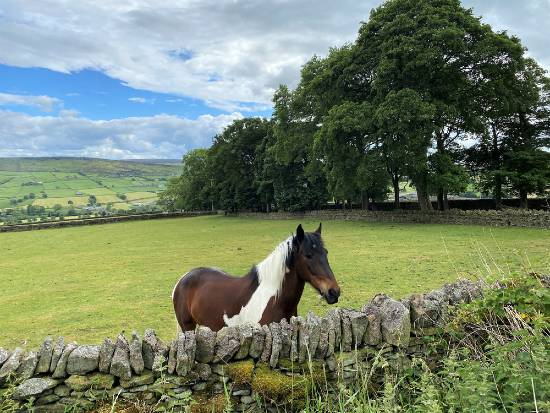
How Can I Set Up My Land to Suit Horses?
Designing a property suitable for horse keeping needs careful consideration. Designs will vary according to land size, pasture quality, and the number and type of horses. You also need to think about how you will manage the horses and land.
If you only have a limited amount of land, you may choose to section off smaller areas. This will mean you can rotate horses between fields to allow for pasture growth and to avoid damage. If you have lots of space, then you might consider larger areas that require less maintenance.
If you have more than one horse, decide if you want to keep them in groups or separately. It’s recommended that horses be kept so that they can always see and interact with other horses. Groups of horses need larger fields; if keeping horses separately you will need more fields that will likely be smaller.
Also, consider how you manage your horses. If you do not want to feed hay, you need to ensure adequate pasture is available. Manure also needs to be managed by cleaning smaller fields or harrowing larger ones.
Using a Track System
Some owners set up a track system for their horses. Fencing is used to create a loop or track that the horse can walk around. There are designated larger areas where horses can sleep, eat, or drink.
The idea behind a track system is to mimic a wild horse’s lifestyle. Feed and water are placed at different points along the track, separate from sleeping areas. The horse must move around the track to find food, then move again to search for water.
You can also place obstacles like logs or water crossings along the track to challenge your horse. Track systems are popular with owners of easy keepers. This is because they can control how much feed the horse gets, and encourage more exercise.
Final Thoughts
Before buying a horse, it is important to ask, how much land does a horse need in this area? Answering this question will tell you how many horses you can have and how best to set up your property. Having the right amount of land is important for the horse’s mental and physical well-being.

